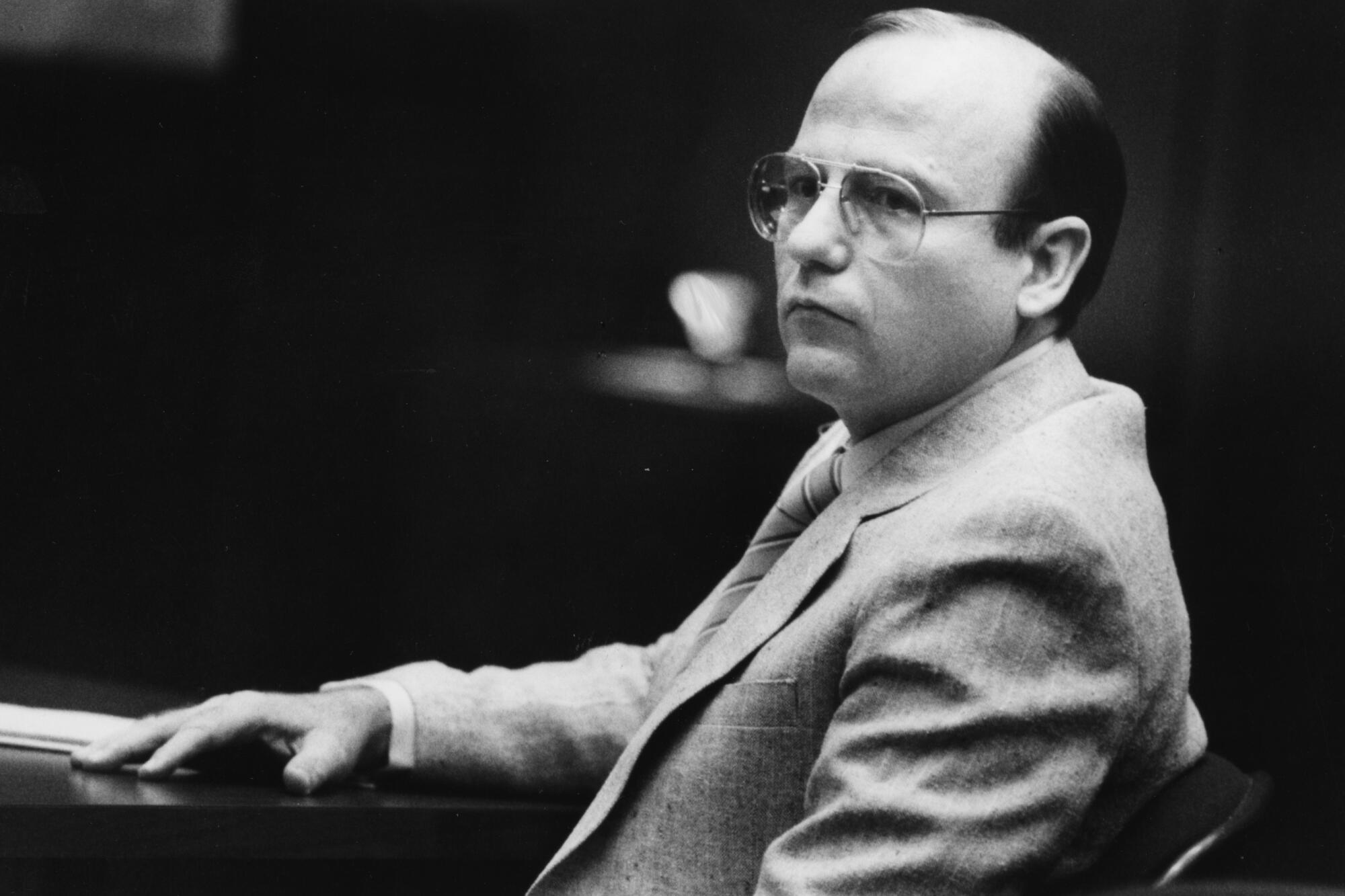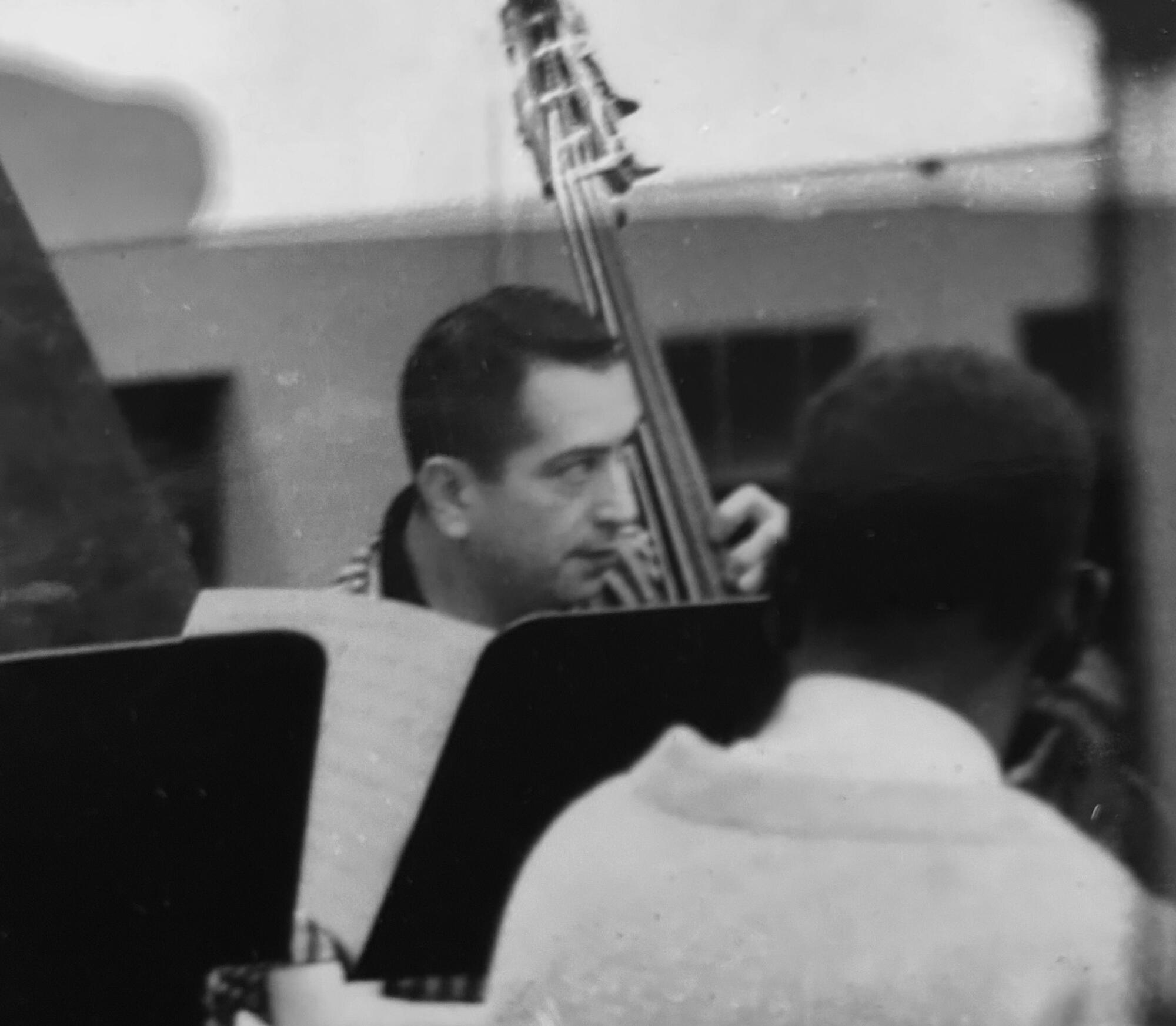
- Share via
The city’s dirtiest cop was also the most colorless, with a forgettable face and a personality as vague as fog. At 77, he has been in lockup for 38 years, more than twice as long as he wore a badge. He has been a tame and quiet inmate, just as he was known — until his capture — as a tame and quiet policeman.
At Mule Creek State Prison, he attends 12-step programs and reads fantasy novels. He has a paralegal certificate, a sister-in-law with a guest house, and a job offer at a law firm if he should ever get out.
But the people with the power to free him keep puzzling over his crimes, demanding explanations, psychological insight, the thinnest ray of sunlight on his motivations. Give us something.
In this series, Christopher Goffard revisits old crimes in Los Angeles and beyond, from the famous to the forgotten, the consequential to the obscure, diving into archives and the memories of those who were there.
William Leasure, killer cop, always disappoints. He blames “low self-esteem” for his run as an outlaw in the long-ago 1980s. He blames “criminal thinking” for disgracing his badge. He blames “questionable characters” and “unwise acquaintances” for leading him astray. It is as close to self-examination as he comes, at least in front of the parole board.
He is stingy with contrition. He admits to the relatively minor crimes, like the serial theft of yachts, insurance fraud and the building of illegal gun silencers. He still denies the big crimes, the ones that put him in prison: orchestrating the contract murders of a beauty shop employee and a jazz bassist.
The beauty shop employee was named Ann Smith. She was 41, shot with a .45 handgun at her mother’s salon in Highland Park in May 1980.
The bassist was named Tony de los Reyes. He was 63, killed with a shotgun blast to the head in the parking lot of a Sherman Oaks lounge in September 1981.

The victims had the bad luck of being pitted against Leasure’s friends in acrimonious divorces. In both cases, the admitted triggerman was a barely literate welder Leasure had met at a gun show.
And in both cases, the shooter would testify that Leasure — a veteran LAPD officer with an unblemished record — planned the killings to look like botched holdups and drove the getaway car.

Leasure grew up in Wayne, Mich. with what he described as “wonderful parents” and a “Beaver Cleaver” childhood. He served with the Marines in Vietnam, loved guns and boasted of his marksmanship.
As an accident investigator in the LAPD’s Central Traffic Division, he was known as Mild Bill. He bragged that he never used his service weapon and did not draw a use-of-force complaint in 17 years with a badge. A nice guy, people agreed.
He was nearing retirement when police caught him on a stolen pleasure boat in May 1986 and linked him to a multimillion-dollar yacht-theft ring. The scheme: steal boats from their slips up and down the coast, disguise them and rename them for sale to unsuspecting buyers.
“When he said ‘Do something,’ you do it… I could either do it or I could be killed myself.”
The LAPD launched a task force. They called their office the Leasure Room. When they searched his Northridge home, they found a stolen car, illegal gun silencers and a cache of random yacht booty.
Fellow officers found it all hard to believe. Mild Bill? At worst, he was a slacker who didn’t like to write tickets and dodged radio calls. Some, however, had noticed that he lived larger than a cop salary allowed. He drove fast Corvettes and owned multiple properties, plus a 42-foot yacht called Thunderbolt.
Leasure would shrug off questions by saying his wife, Betsy Mogul, took care of him. She worked as an assistant L.A. city attorney and made $78,000 a year, more than twice his salary. Police dug through her life. How much did she know about her husband’s criminality? All they found was a case for possible tax fraud, which she beat at trial.
Enter Dennis France, a runty cop groupie who had befriended Leasure at a Pomona gun show and liked to go on ride alongs with him.
“Me and Bill had done a lot of things together,” France would testify. “We’d bought silencers, we’d stole boats, we’d killed people, we’d broken into places.” He said Leasure was the wheelman for the killings outside the Sherman Oaks lounge and in the Highland Park beauty shop. “Plus, he paid me and arranged ‘em and set ‘em up.”

France seemed to idolize Leasure, but he also claimed to be terrified of him. “When he said ‘Do something,’ you do it,” France said. “I could either do it or I could be killed myself.”
By France’s account, Leasure instructed him to put a sock over the barrel of the .45 that killed Ann Smith at the salon, to catch the shell casing. When the casing tumbled out anyway, Leasure docked $500 from France’s $3,500 fee.
In exchange for helping to nail Leasure, France got immunity from the D.A.’s office — a deal that would forever enrage detectives on the case. Police sent France into a bugged jail in hopes of getting Leasure to incriminate himself, a scheme the cautious Leasure foiled by writing his remarks on a piece of paper, then erasing them.
France went in again, and this time there was a tiny camera in the ceiling. The pivotal moment came when he asked Leasure what he had done with the gun from “Avenue 60,” a reference to the location of the beauty shop murder.
Leasure wrote a word on a piece of paper. In sight of the hidden camera, he held it up to the glass.
“He’s quite adept at presenting himself as a mild and meek human being… You’d say, ‘Nice guy, totally colorless.’ You wouldn’t even know his personality.”
“Melted,” it said.
He wrote another note: “Dump everything illegal.”
Defense attorneys struggled mightily, and unsuccessfully, to find an innocent explanation for the notes when Leasure went on trial in 1991, charged with two counts of murder and facing the death penalty. They attacked France as a liar who had fingered Leasure to save himself.
By appearances, Leasure was not a plausible hit man, and explaining his motives was tricky. The money said to be exchanged for the killings was just a few thousand dollars. The prosecutor, James Koller, settled on a portrait of Leasure as a veteran cop who had grown bored with writing traffic tickets and was hungry for excitement. He turned to murder “almost for the thrill — to get away with it.”
The estranged spouses who solicited the killings had already been convicted. In Leasure’s trial, the first jury deadlocked and a second was being picked when he pleaded no contest to two counts of second-degree murder. He got 15 years to life. He claimed to fear the anti-police sentiment that had been growing since the beating of Rodney King eight months earlier, a case which had overshadowed his sparsely-attended trial.
The prosecutor called Leasure “the most corrupt policeman in the city of Los Angeles in its history.”
Leasure called himself “the nicest, quietest, mildest guy you’ll ever want to meet.”

Addison “Bud” Arce is one of the LAPD detectives who built the case against Leasure. Now retired, he testifies against him at parole hearings. He thinks Leasure could have walked free years ago, if he would have just come clean. But something in his nature prevents him.
“If he went in and did mea culpas, he would have been out,” Arce says. “More so now, when they parole anybody for just about anything.”
Instead, year after year, Leasure sits before the parole board and portrays himself as a man who was railroaded, who copped a plea to murders he had nothing to do with. He projects an air of befuddled harmlessness. When the questioning grows sharp and his memory for details fails, he blames “brain damage” from his cholesterol pills.
“I had self-esteem issues,” Leasure told the board in 2021. “I had greed issues. I thought that by impressing others, that they would like me, and I would feel good about myself. And I learned all that was wrong through self-help and recovery.”

He had a happy childhood, but even then, “I had self-esteem issues. And as a Marine, I had self-esteem issues. As a police officer, I had self-esteem issues.” His marriage to a city prosecutor did not help. His wife’s fancy friends, the judges and lawyers, thought he was beneath her. At one point, he almost broke up with her, “and it affected my self-esteem.”
“What I’ve gotten from you today is you had some self-esteem issues,” said commissioner Michele Minor.
He continued to deny the murders. He was asked about the “Melted” note.
“There is no such note ever,” Leasure insisted. “It doesn’t exist.”
Anthony de los Reyes Jr., 81, the son of the murdered jazz musician, has testified at eight or nine of the hearings, to make sure his father is not forgotten.

If you have information on old crimes, famous, once-famous or obscure, contact [email protected]
“He’s quite adept at presenting himself as a mild and meek human being,” Reyes said. “You’d say, ‘Nice guy, totally colorless.’ You wouldn’t even know his personality. He hasn’t changed from the first time I had the displeasure of meeting him.
“The man’s a born liar, and he says everything in the same monotone.
“No emotion. Absolutely none.”
The ritual has played out before the parole board 13 times. Twice, the board decided Leasure was safe to release, and both times Gov. Gavin Newsom reversed the decision. The governor found he lacked “insight into his criminality and the causative factors.”
Leasure, who turned down an interview request from The Times, gets to make his case again in September. Arce, the retired detective, expects to be there to remind the board of the details of Leasure’s crimes.
He calls him “this little milquetoast LAPD cop” and “Walter Mitty.” He has spent as much time as anyone pondering the motives of the meek officer who moonlighted as a hit man, and they remain fuzzy. It’s hard to believe it was just money. Probably, he thinks, Leasure arranged murders so that people would owe him; he liked that.
“It is confusing,” said Arce, now 79. “People have asked me over the years, ‘What kind of guy is this?’ I can’t tell you.”
More to Read
Sign up for Essential California
The most important California stories and recommendations in your inbox every morning.
You may occasionally receive promotional content from the Los Angeles Times.













